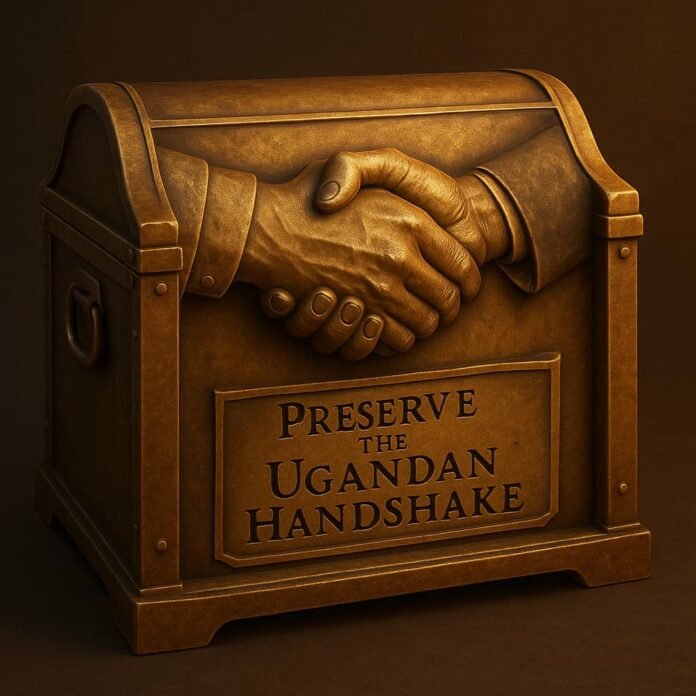The Ugandan Handshake: A Case for Preservation of a Silent National Treasure
By: Isaac Christopher Lubogo
Introduction: The German Lady and the Mystery of the Handshake
I still remember the day as if time itself slowed to immortalize it. A German lady—gracious, confident, and curious—looked me squarely in the eye after I had done something for her. Instead of the usual “thank you” or a polite smile, she stretched out her hand and, with almost commanding warmth, said: “Give me the Ugandan handshake.”
I was caught off guard. My mind raced—the Ugandan handshake? What in the world is that? Had I, a son of this soil, missed out on something the world already claimed as distinctly ours? I asked her with a mixture of confusion and curiosity: “What is the Ugandan handshake?”
Without hesitation, she took my palm in hers. What followed was not an ordinary clasp, but a threefold rhythm—first the firm grip, then the thumb hook, then the return clasp. It was like a silent dance, a coded language of connection that needed no interpreter. In that moment, I felt strangely rebuked: here was a foreigner teaching me the choreography of my own culture.
It was then that I realized: this was no mere handshake. It was Uganda’s unsung anthem, whispered not in words but in the meeting of hands. And in that realization, a duty was born within me: to defend it, to preserve it, and to proclaim its hidden majesty before it dissolves into the oblivion of forgotten customs.
The Anatomy of the Handshake
The Ugandan handshake unfolds in three movements:
1. The initial clasp – a recognition of existence, the first acknowledgment of the other.
2. The thumb grip – a moment of intimacy, of lowering the guard, symbolizing that our friendship is firm enough to shift into a grip less formal, more personal.
3. The return clasp – a reaffirmation, reminding both parties that we began together and we end together, in respect and goodwill.
This rhythm—clasp, hook, clasp—is no accident. It mirrors our worldview: life begins in respect, deepens in trust, and closes in harmony.
The Philosophy Behind the Gesture
At its core, the Ugandan handshake is not just about touch; it is about philosophy embodied in motion. It carries with it three lessons for humanity:
That every encounter must begin with recognition.
That depth of relationship requires a lowering of the guard.
That no matter how much we disagree, endings must circle back to mutual respect.
In other words, the handshake is an enactment of Ubuntu—I am because we are. It teaches us that human dignity is not proven in words alone but in the gestures that bind flesh to flesh and heart to heart.
Its Uniqueness in the World
Yes, many nations have their own greeting rituals—bows in Japan, kisses on the cheeks in Europe, elaborate handshakes in West Africa. But Uganda’s three-step handshake is unique in its universality and simplicity. It requires no language, no ceremonial training, and no hierarchy. Whether in Kampala’s boardrooms or in the dusty villages of Busoga, it is the same: clasp, hook, clasp.
It is uniquely ours, and yet paradoxically, it took a German lady to remind me of its value. That, perhaps, is the tragedy of our times—we allow the treasures of our identity to be celebrated more abroad than at home.
A Case for Preservation
Globalization, like a flood, threatens to wash away these subtle emblems of identity. Already, fist bumps and high-fives have begun to edge out the handshake among the urban youth. Yet if we lose this, we lose more than a gesture—we lose a philosophy, a rhythm of togetherness.
I make this appeal, therefore, to my nation:
Let schools teach it as part of cultural education.
Let artists and filmmakers embed it in Ugandan storytelling.
Let diplomats carry it abroad as a cultural signature.
Let families pass it on consciously to children, as part of their inheritance.
For if we do not fight for it now, we shall one day realize that we traded our silent anthem for borrowed trends that carry no soul.
Conclusion: A Touch That Heals Humanity
If humanity suffers today from alienation, from loneliness in the age of smartphones, from the coldness of individualism, then perhaps the Ugandan handshake is one small antidote. It is proof that connection need not be grand—it can be as simple as palms meeting, thumbs locking, hearts aligning.
To preserve the Ugandan handshake is to preserve more than a greeting. It is to preserve our humanity. It is to proclaim to the world that Uganda may be a small nation, but in the clasp of our hands lies a truth for all mankind: that connection, trust, and respect must never die.








